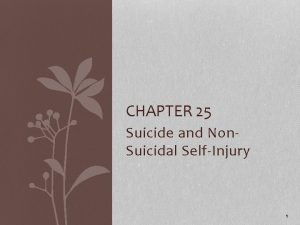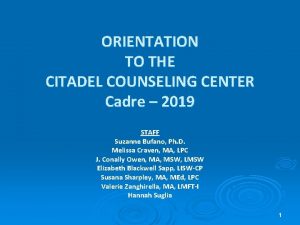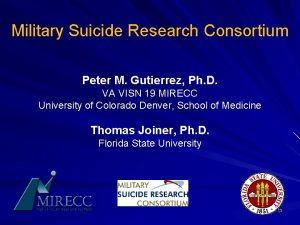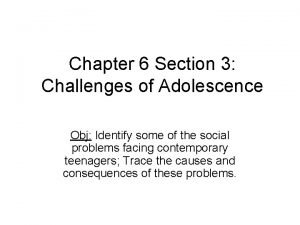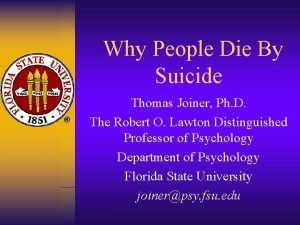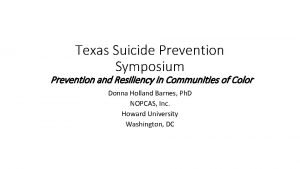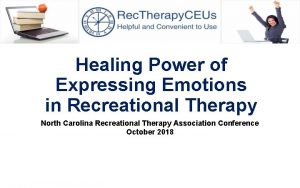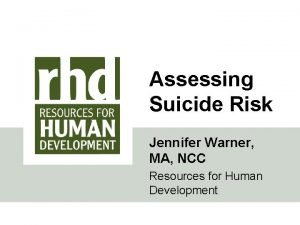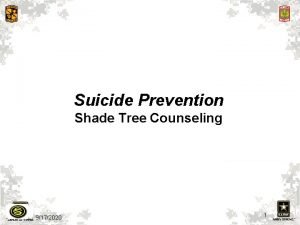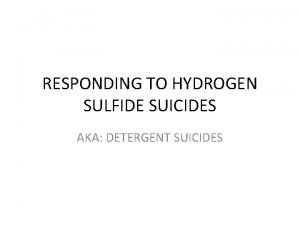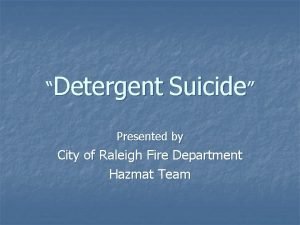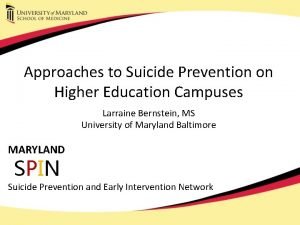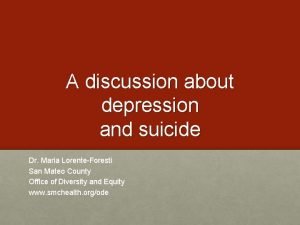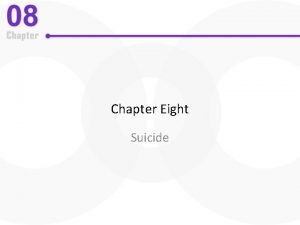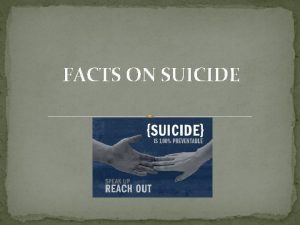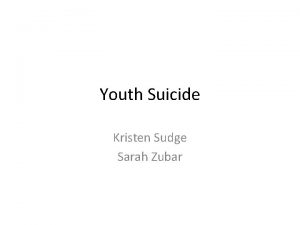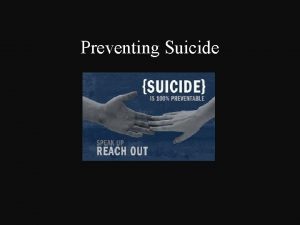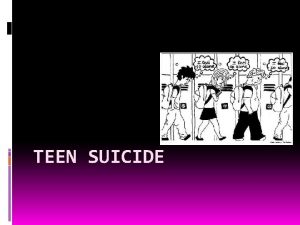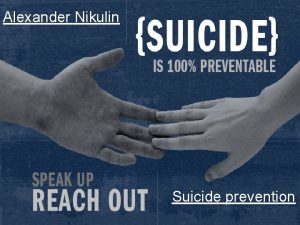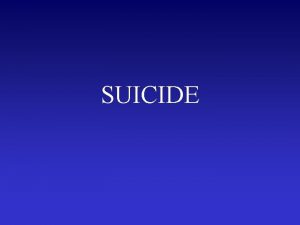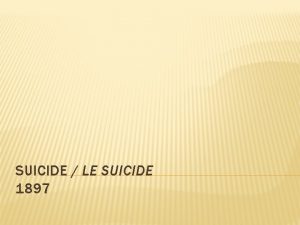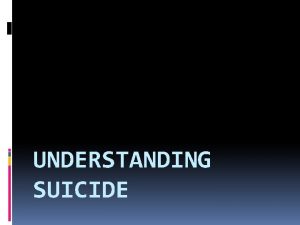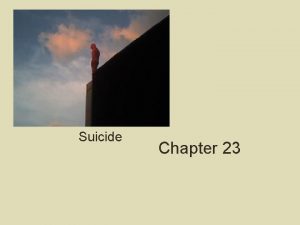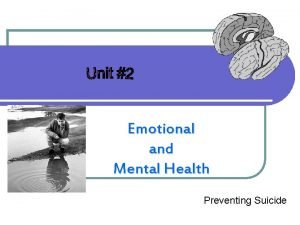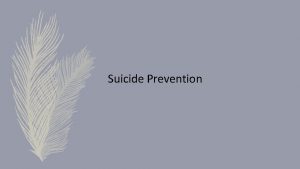Chapter 10 Suicide Suicide Suicide is a major






























- Slides: 30

Chapter 10 Suicide

Suicide ¨ Suicide is a major health problem in the world • It ranks among the top 10 leading causes of death • There about 31, 000 suicides per year in the U. S. ¨ Many more unsuccessfully attempt suicide than actually succeed • Such attempts are called “parasuicides” • There about 600, 000 attempts per year in the U. S. Slide 2

Suicide ¨ It is difficult to obtain accurate figures on suicide rates • Many “accidents” may be intentional deaths ¨ Suicide is not classified as a mental disorder in the DSM-IV • While suicide is often linked to depression, about half of all suicides result from other mental disorders or involve no clear mental disorder Slide 3

What Is Suicide? ¨ Shneidman defines suicides as an intentioned death – a self-inflicted death in which one makes an intentional, direct, and conscious effort to end one’s life ¨ He characterizes four kinds of suicide seekers… Slide 4

What Is Suicide? ¨ Shneidman’s characterizations of suicide seekers: • Death seekers – clearly intend to end their lives • Death initiators – intend to end their lives because they believe that the process of death is already underway • Death ignorers – do not believe that their self-inflicted death will mean the end of their existence • Death darers – have ambivalent feelings about death and show this in the act itself Slide 5

What Is Suicide? ¨ When individuals play indirect, hidden, partial, or unconscious roles in their own deaths, Shneidman classifies them in a category called “subintentional death” • True intent is unclear Slide 6

How Is Suicide Studied? ¨ Suicide researchers face a major obstacle: their subjects are no longer alive ¨ Researchers use two different strategies to try to overcome this obstacle: • Retrospective analysis • Studying people who survive their suicide attempts Slide 7

Patterns and Statistics ¨ Researchers have gathered statistics regarding the social contexts in which suicides take place • Suicide rates vary from country to country, with religious devoutness (not simply affiliation) helping to explain some of the difference • For example, countries that are largely Catholic, Jewish, or Muslim generally tend to have low suicide rates Slide 8

Patterns and Statistics ¨ The suicide rates of men and women also differ: • Women have a higher attempt rate (3 x men) • Men have a higher completion rate (3 x women) • Why? Different methods have differing lethality • Men tend to use more violent methods (shooting, stabbing, or hanging) than women (drug overdose) • Guns are used in nearly two-thirds of male suicides in the U. S. , compared to 40% of female suicides Slide 9

Patterns and Statistics ¨ Suicide is also related to marital status and level of social support • Married people, especially those with children, tend to have a fairly low suicide rate • Divorced people have the highest rate of all Slide 10

Patterns and Statistics ¨ In the U. S. , suicide also seems to vary according to race • The suicide rate of white Americans (12 per 100, 000) is almost twice as high as that of African Americans and members of other racial groups • A major exception to this pattern is the very high suicide rate of Native Americans, which overall is 1. 5 times the national average • In some tribes the rate is as high as 4 to 10 times the national average Slide 11

What Triggers a Suicide? ¨ Suicidal acts may be connected to recent events or current conditions in a person’s life ¨ Common triggers include stressful events, mood and thought changes, alcohol and other drug use, mental disorders, and modeling Slide 12

Stressful Events and Suicide ¨ Researchers have counted more stressful events in the lives of suicide attempters than in the lives of matched controls ¨ Both immediate and long-term stresses can be risk factors for suicide • Immediate stresses can include the loss of a loved one, the loss of a job, or natural disaster Slide 13

Stressful Events and Suicide ¨ Long-term stressors can include: • Serious illness • Suicides related to serious illness have become more common in recent years • Abusive environment • Prisoners of war, inmates of concentration camps, abused spouses, abused children, and prison inmates have tried to end their lives • Occupational stress • Psychiatrists and psychologists, physicians, nurses, dentists, lawyers, farmers, and unskilled laborers have particularly high suicide rates • Work outside the home may be linked to lower suicide rates among women, contrary to previously-held beliefs Slide 14

Mood and Thought Changes ¨ Many suicide attempts are preceded by changes in mood • These changes may not be enough to warrant a diagnosis of a mental disorder • The most common change is a rise in sadness • Increases in feelings of anxiety, tension, frustration, anger, or shame are also common • Shneidman calls this “psychache”: a feeling of psychological pain that seems intolerable to the person Slide 15

Mood and Thought Changes ¨ Suicide attempts may also be preceded by shifts in patterns of thinking • Individuals may become preoccupied, lose perspective, and see suicide as their only option • They often develop a sense of hopelessness – a pessimistic belief that their present circumstances, problems, or mood will not change • Some clinicians believe that a feeling of hopelessness is the single most likely indicator of suicidal intent Slide 16

Mood and Thought Changes ¨ People who attempt suicide may experience dichotomous thinking, viewing problems and solutions in rigid either/or terms • The “four-letter word” in suicide is “only, ” as in “suicide was the only thing I could do” Slide 17

Slide 18

What Are the Underlying Causes of Suicide? ¨ Most people faced with difficult situations never attempt suicide • In an effort to explain suicide-proneness, theorists have proposed more fundamental explanations for self-destructive behavior • Leading theories come from the psychodynamic, sociocultural, and biological perspectives • None of these explanations has received strong research support Slide 19

Underlying Causes of Suicide: The Psychodynamic View ¨ Theorists believe that suicide results from depression and from anger at others that is redirected toward oneself • In support of this view, researchers have often found a relationship between childhood losses and later suicidality ¨ Additionally, Freud proposed that humans have a basic death instinct (“thanatos”) that operates in opposition to the life instinct • While most people learn to direct their death instinct toward others, suicidal people directly it at themselves Slide 20

Underlying Causes of Suicide: The Sociocultural View ¨ Durkheim argues that the probability of suicide is determined by how attached a person is to such social groups as the family, religious institutions, and community • The more thoroughly a person belongs, the lower the risk of suicide ¨ Based on this premise, he developed several categories of suicide, including egoistic, altruistic, and anomic suicide… Slide 21

Underlying Causes of Suicide: The Biological View ¨ Family pedigree and twin studies support the position that biological factors contribute to suicidal behavior • For example, there are higher rates of suicide among the parents and close relatives of those who commit suicide than among nonsuicidal people ¨ As always with this type of research, however, nonbiological factors such as shared environment must also be considered Slide 22

Underlying Causes of Suicide: The Biological View ¨ Recent laboratory research has offered more direct support for a biological model of suicide • Serotonin levels have been found to be low in people who commit suicide • There is a known link between low serotonin and depression • There is evidence, though, of low serotonin activity among suicidal subjects with no history of depression • Serotonin activity may contribute to aggressive behavior Slide 23

Treatment and Suicide ¨ Treatment of suicidal persons falls into two categories: • Treatment after suicide has been attempted • Suicide prevention Slide 24

What Treatments Are Used After Suicide Attempts? ¨ After a suicide attempt, most victims need medical care ¨ Psychotherapy or drug therapy may begin once a person is medically stable • Many suicidal people fail to receive psychotherapy after a suicide attempt Slide 25

What Treatments Are Used After Suicide Attempts? ¨ Therapy goals: • Keep the patient alive • Help them achieve a nonsuicidal state of mind • Guide them to develop better coping strategies ¨ Various therapies and techniques have been employed ¨ Treatment appears to be somewhat successful Slide 26

What Is Suicide Prevention? ¨ There are hundreds of suicide prevention centers in the U. S. ¨ There also are hundreds of suicide hot lines (24 -hour-a-day telephone services) • Hot lines are predominantly staffed by paraprofessionals – people trained in counseling but without formal degrees Slide 27

What Is Suicide Prevention? ¨ Both suicide prevention programs and suicide hot lines provide crisis intervention ¨ The general approach includes: • Establishing a positive relationship • Understanding and clarifying the problem • Assessing suicide potential • Assessing and mobilizing the caller’s resources • Formulating a plan Slide 28

What Is Suicide Prevention? ¨ Although crisis intervention appears to be sufficient treatment for some suicidal people, longer-term therapy is needed for most ¨ Another way to prevent suicide may be to limit the public’s access to common means of suicide • Examples: gun control, safer medications, and car emissions controls Slide 29

Do Suicide Prevention Programs Work? ¨ It is difficult to measure the effectiveness of suicide prevention programs • Prevention programs do seem to reduce the number of suicides among those high-risk people who do call ¨ Several theorists have argued for more effective public education about suicide, as education is the ultimate form of suicide prevention Slide 30
 Chapter 5 lesson 3 suicide prevention answer key
Chapter 5 lesson 3 suicide prevention answer key Chapter 25 suicide and nonsuicidal self injury
Chapter 25 suicide and nonsuicidal self injury Como ser una suicide girl
Como ser una suicide girl Mad acronym suicide prevention
Mad acronym suicide prevention Citadel cadet suicide
Citadel cadet suicide Youth suicide research consortium
Youth suicide research consortium Rvguev
Rvguev Food intoxication icd 10
Food intoxication icd 10 Egoistic suicide
Egoistic suicide What are the challenges of adolescence
What are the challenges of adolescence Why people die by suicide joiner
Why people die by suicide joiner Suicide prevention chain teach
Suicide prevention chain teach Texas suicide prevention symposium
Texas suicide prevention symposium Suicide prevention sink
Suicide prevention sink Loudoun county suicide
Loudoun county suicide Break up suicide
Break up suicide Synthase vs synthetase
Synthase vs synthetase Digestive enzymes and their functions table
Digestive enzymes and their functions table Dr. spock's son committed suicide
Dr. spock's son committed suicide Slap suicidality
Slap suicidality Army suicide prevention situational questions
Army suicide prevention situational questions Detergent suicides
Detergent suicides Mathieu sohier
Mathieu sohier Prévention du suicide
Prévention du suicide Detergent suicide
Detergent suicide Cabinet hypnose breuschwickersheim
Cabinet hypnose breuschwickersheim Livi jaay suicide
Livi jaay suicide Moorpark college criminal justice
Moorpark college criminal justice Dr maria suicide
Dr maria suicide Desitter suicide
Desitter suicide Suscinio suicide
Suscinio suicide

